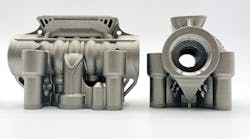At a Glance:
- Aidro successfully redesigned hydraulic manifolds with additive manufacturing methods for agricultural machines.
- The partnership between Aidro and Desktop Metal will amplify high-volume production of hydraulic products using additive manufacturing methods.
- Benefits of using additive manufacturing: R&D; customization; consolidating multiple components.
You’ve witnessed the macro trend: The focus on developing smart equipment using innovative materials and processes create new products and service-based models with superior outcomes.
Aidro, a hydraulics and fluid power systems manufacturer based in Taino, Italy, is a textbook example. Back in 2017, Aidro’s CEO, Valeria Tirelli, and her team used additive manufacturing methods to introduce a new generation of hydraulic components and to overcome the limits of traditionally manufactured parts.
The strategic move to introduce additive manufacturing would set Aidro on a transformative journey that required the company to redesign and produce 3D products such as 3D-printed hydraulic spools, heat exchangers, valves and high-pressure hydraulic manifolds. Since then, the company has seen a surge in digital transformation, explained Tirelli.
Moreover, it ultimately spawned the recent acquisition of the company by a 3D printing unicorn, Burlington, Mass.-based Desktop Metal. The new partnership will effectively amplify Aidro’s capabilities to deliver high-volume production of fluid power systems through additive manufacturing and to enter new markets.
In the following Q&A with Machine Design, Tirelli reflected on why introducing additive manufacturing approaches triggered a new way of thinking for a 40-year-old, mid-sized conventional hydraulics manufacturing company and what the acquisition means for its future.
(The interview has been edited for length and clarity.)
Machine Design: In the transaction with Desktop Metal, Aidro brings specialized knowledge and expertise in hydraulic components and fluid power systems for oil and gas, aerospace and industrial sectors. What will it mean to you to be able to combine and to leverage Desktop Metal’s capabilities?
Valeria Tirelli: Desktop Metal is a big company now with a lot of technologies. And we decided to join forces because we see that there is a big potentiality for fluid power using additive manufacturing. There are a lot of benefits of this technology, such as lightweight parts, to design complex parts using less material compared to conventional manufacturing, and especially compared to casting.
The meaning of additive manufacturing is to add material only where it is needed. Thanks to our ability to design fluid parts with this new additive manufacturing approaches, we are able to reduce the weight of the part, use less material, produce it faster compared to conventional methods. And, we are moving now to high-volume production that will be possible with Desktop Metal’s technology of binder jetting.
MD: What’s next for Aidro? Can you tell us more about your transition and how you will be working together?
VT: We are all excited and ready to go to the next step from being a medium-sized company into a big family. Desktop Metal is a big family for us, and we will have access to a lot of technical resources, but also to share new ideas and to develop new projects together. We are really thrilled about this new adventure because, from the Italian perspective, we are moving to the U.S., and we will add new design capabilities, new machines and new people…I think we are really ready to grow and to boost additive manufacturing. We need to prove to the industry that additive manufacturing is a good technology for fluid power.
MD: Reflect on how you transitioned from being a conventional hydraulics manufacturer to adding additive manufacturing to the mix. Why did you add AM to your offering?
VT: We started some years ago to investigate additive manufacturing. At the beginning it was only with polymer materials. And we purchased the first two FDM printers—[relatively] easy technology. We used these printers to make tooling or prototypes for our conventional hydraulics valves. But the more we used this technology, we started to think differently and to see that additive manufacturing responds to our needs in a very fast way, and in a way that is not possible with the conventional manufacturing. So that’s why we started to think why we can produce functional parts with additive manufacturing. Then we moved from using polymers to metal.
At the beginning, we conducted research with an Italian university to prove that additive manufacturing is a good technology for hydraulics. Four or five years ago there were no other companies using this technology, so we were a pioneer in fluid power. In 2017 we exhibited at the Hanover Messe—I’m sure that you know this is the big fair in Hanover, Germany. We had a small booth there in the Italian pavilion. We received a lot of visitors because they were interested to see the first 3D-printed manifold or 3D-printed valves. We were the first to show that it’s possible to produce functional parts with additive manufacturing.
After a period of testing mechanical properties, fatigue, pressure and so on, to validate the technology, we were amazed by its potential. We started to promote and use the technology mainly for hydraulics, but also in other sectors, like oil and gas and aerospace. So, we started to speak with big companies that we didn’t have the opportunity to be in contact with before. Technical people, especially, were very interested in knowing more about additive manufacturing.
MD: What are the benefits of additive manufacturing and producing AM components? Why do you think that there is such interest in growing in that direction?
VT: There are very many benefits in different fields. For example, in the research and the development of new products. Thanks to additive manufacturing, we’re able to produce the first prototypes rapidly. Also, in one printing we can produce the same prototype with different features, for example, and test all the different versions to validate which prototype is the best one.
But it’s not only at the research and prototyping level that additive manufacturing is interesting. We started to design—with the new mentality of additive manufacturing—functional parts for small series CETOP valves, which we made in stainless steel. We added this material especially for corrosion environments.
And we were able to have lighter components. To lighten components is very important for mobile applications, like agricultural machinery or off-highway vehicles, where more electrification is a new trend. And of course, it’s possible to reduce the weight of the different hydraulic components using additive manufacturing. This means using less energy to move the machine and less oil consumption.
Also, the possibility to customize the shape and, in some cases, the shape of the hydraulic systems and hydraulics component that should be customized to take into account the space that is available inside the machine. So, more and more, we are able to exactly fit the spaces that are in the systems, and create the exact part with the exact shape that is needed.
Another benefit is the possibility to combine multiple components into one. Just a few weeks ago we presented an approach with a CNH Industrial, where we combined two hydraulic manifolds into one. For example, we reduced the assembly time, we reduced the ceilings and the o-rings that connect into manifolds. We also have benefits in the logistics; because we have only one part there are benefits for the purchasing department. So, you see, there are very different benefits in different applications.
More and more, we see that in the future, different industries will be interested in additive. The oil and gas industry is one example. We started many collaborations with oil and gas companies. Also, working on the digital inventory is a new trend. The idea to move from physical inventory (or physical warehouse) to a digital file that can be 3D-printed on demand exactly when it is needed and where it is needed. This is something for the future, but we are working now to validate additive manufacturing for digital inventory.
MD: Can you elaborate on how you’re developing smart parts?
VT: We are working with an Italian company to produce valves for oil and gas. Their inventories need to be ready with many spare parts. We worked with them to evaluate and identify which components of the valves can be digitalized and 3D printed. Not everything can be 3D printed. But it’s really important to start to evaluate. We identified two components, and transformed the valve with the 3D printing files. This means, the valve components can be printed with laser power bed fusion or with the other technology. After the printing, we tested the component and we also qualified the component.
More and more we see that it’s really important to follow process and procedures in accordance with qualification systems. And, more and more industries are using additive manufacturing and starting to have standards for different sectors. Aerospace is at the forefront of standard procedures for additive manufacturing, but oil and gas and other sectors are following
MD: Tell us a bit more about your role after you succeeded your father, Paolo Tirelli, as CEO in 2012. What leadership advice did he pass along to you?
VT: Thank you for this question. My father was an engineer. He started working for a big Italian fluid power company not far from where we are based. After about 25 years of experience working for this company, my father decided to open his own business. Aidro was created in 1982. He worked a lot. He was really is a big entrepreneur but he also loved his activities. He created Aidro as his family house; the people working at Aidro are a kind of family. Some have worked at Aidro for 25 years.
This is really important to me, and this is the message that I received from my father: to create a very friendly environment because the people are the main point of the company. Taking care of employees is something that takes time, but it’s really important. The best part of my job is to be the general manager of Aidro.


